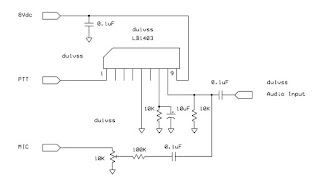My new company just bought 10 pcs of Kenwood TK-3000:M6 radio to help our communication inside the plant but the supplier only provide a single programmed frequency in the channel knob. Another problem arise after we found out that the typical range of this unit is not sufficient to cover the entire plant and the only way to solve the problem is to deploy a repeater.
To begin with my repeater project, I need to construct first a programmer and found some some useful circuit here. "http://www.repeater-builder.com/kenwood/kenwood-software-and-cable-list.html" . I just use 2sc9013 NPN transistor and 1N4148 as required in the schematic.
Using my trusted "ugly construction technique", my programmer is now ready. Few more things needed in order to start programming and these are;
- KPG-137D software from Kenwood
- USB-Serial converter
Some settings in the KPG-137D needs to be set correctly such as the port number assigned in the usb-serial converter and the model / frequency range of the radio.
If you need a copy of the software just drop me a message below. ---73 de du1vss

























